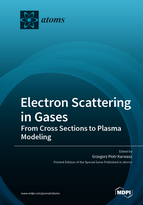Vibrational Excitation Cross-Section by Positron Impact: A Wave-Packet Dynamics Study
Round 1
Reviewer 1 Report
Dear Editor,
The manuscript entitled “Vibrational excitation cross section by positron impact. A wavepacket dynamics study” reports on a model calculation that treats the interaction of a positron with a diatomic molecule. They use a potential energy surface (PES) that couples a correlation-polarization potential curve, for the positron-target interaction, with a hydrogen-like harmonic oscillator. They apply their model to calculate the cross section for the excitation of the first vibrational mode for which their results are in good agreement with previous reports. The authors claim that their model calculations support the picture of a positron that couples to the target vibration by responding instantly to an interaction potential which depends on the target vibrational coordinate.
The manuscript is very well written, with only a few minor grammatical errors, it is very clearly written even for the non-specialist, and the presented results seem solid. However, the reader is left with the fundamental question of how this model behaves for higher vibrational states where the harmonic oscillator approximation deviates substantially. This should define the limitations of this method, as well as the conclusions so far, and the authors should include such an analysis in the next version of the manuscript. Some minor corrections to the text are the following:
- Do not change paragraph after the equations
- Line 57. “positon” should read “positron”.
- Line 61. “can couples” should read “couples”
- Line 114. “In equation above” should read “In Eq. 10”
- Line 118. “Eqs.” should read “Eq.”
- Line 167. “apolar” should read “polar”
- Reference 5. Write H2 and N2 with subscripts for 2
- Reference 5. Write H2 with subscript for 2
Author Response
Please see the attachment.
Author Response File: ![]() Author Response.pdf
Author Response.pdf
Reviewer 2 Report
The paper of Poveda et al. provides calculations of the vibrational excitation cross section of a diatomic molecule by positron impact. Using wavepacket based calculations, they determine the cross section as a function of incident energy, and compare against existing theoretical and experimental data.
Although the comparisons turn out to be favourable, and some physical inferences are made, my main issue with the paper is that the calculations contain so many convergence parameters to be chosen, for the initial wave packet, the potentials, and the damping during propagation. I would like to see some further justification for these choices. Some justification is provided for the rho parameter in Eq.(6) and for the a and alpha0 in Eq.(5), but it seems that the results are highly sensitive to these parameters (as shown in Fig.3). So, I have to ask:
1. Are the results also sensitive to the damping in Eq.(12)? Can calculations not be performed without this damping, with a box sufficiently large to avoid reflections? Have the authors justified their choice of damping parameters before in a previous paper? If not, they should do so here.
2. Does the shape of the Gaussian wave packet in Eq.(11) have much of an effect on the cross section?
3. The apparent ‘best case’ result in Fig.3 (red curve) is obtained with rho=5, a=4.35, alpha0 = 5.18. Would any other combination of these parameters give a similar result? If this is the case, it could cast doubt on the inferences made regarding the weak attraction of the positron and target, which is based on the values rho ~ 5, alpha0 ~ 5. If it is not the case, then their current conclusions will be validated to some degree.
I recommend that the authors address these points in a revision before the manuscript can be published.
Author Response
Please see the attachment.
Author Response File: ![]() Author Response.pdf
Author Response.pdf
Round 2
Reviewer 2 Report
In the revised manuscript, the authors have addressed my comments, by adding additional text and references. I am satisfied with the response, and recommend that the paper is published in its current form.





